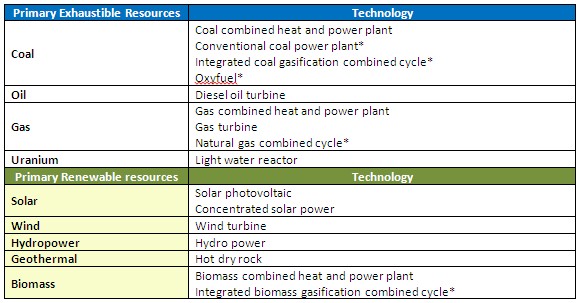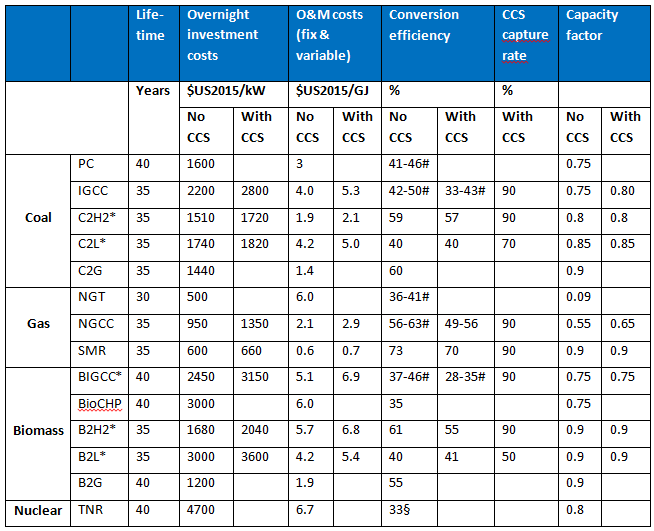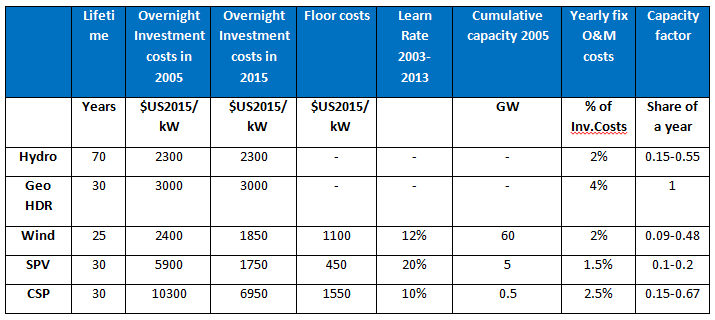Electricity - REMIND-MAgPIE
| Corresponding documentation | |
|---|---|
| Previous versions | |
| Model information | |
| Model link | |
| Institution | Potsdam Institut für Klimafolgenforschung (PIK), Germany, https://www.pik-potsdam.de. |
| Solution concept | General equilibrium (closed economy)MAgPIE: partial equilibrium model of the agricultural sector; |
| Solution method | OptimizationMAgPIE: cost minimization; |
| Anticipation | |
Around twenty electricity generation technologies are represented in REMIND, see <xr id="tab:REMIND_electricity_technologies"/>, with several low-carbon (CCS) and zero carbon options (nuclear and renewables).
Table 1. Energy Conversion Technologies for Electricity (Note: † indicates that technologies can be combined with CCS). <figtable id="tab:REMIND_electricity_technologies">
| Energy Carrier | Technology |
|---|---|
| Primary exhaustible resource | |
| Coal |
|
| Oil |
|
| Gas |
|
| Uranium |
|
| Primary renewable resource | |
| Solar |
|
| Wind |
|
| Hydropower |
|
| Biomass |
|
| Geothermal |
|
| Secondary energy type | |
| Hydrogen |
|
</figtable>
<figure id="fig:REMINDtable_4">
 </figure>
</figure>
Table 2. Techno-economic characteristics of technologies based on exhaustible energy sources and biomass [1]; [2]; [3]; [4]; [5]; [6]; [7]; [8]; [9]; [10]; [11]; [12]; [13].
<figtable id="tab:REMINDtable_5">

Abbreviations: PC - pulverized coal, IGCC - integrated coal gasification combined cycle, CHP - coal combined heat and power plant, C2H2 - coal to hydrogen, C2L - coal to liquids, C2G - coal gasification, NGT - natural gas turbine, NGCC - natural gas combined cycle, SMR - steam methane reforming, BIGCC – Biomass IGCC, BioCHP – biomass combined heat and power, B2H2 – biomass to hydrogen, B2L – biomass to liquids, B2G – biogas, TNR - thermo-nuclear reactor; * for joint production processes; § nuclear reactors with thermal efficiency of 33%; # technologies with exogenously improving efficiencies. 2005 values are represented by the lower end of the range. Long-term efficiencies (reached after 2045) are represented by high-end ranges.
For variable renewable energies, we implemented two parameterized cost markup functions for storage and long-distance transmission grids - see Section Grid and Infrastructure. To represent the general need for flexibility even in a thermal power system, we included a further flexibility constraint based on Sullivan [14].
The techno-economic parameters of power technologies used in the model are given in <xr id="tab:REMINDtable_5"/> for fuel-based technologies and <xr id="tab:REMINDtable_6"/> for non-biomass renewables. For wind, solar and hydro, capacity factors depend on grades, see Section Non-biomass renewables.
Table 3. Techno-economic characteristics of technologies based on non-biomass renewable energy sources (Neij et al. 2003; Nitsch et al. 2004; IEA 2007a; Junginger et al. 2008; Pietzcker et al. 2014).
